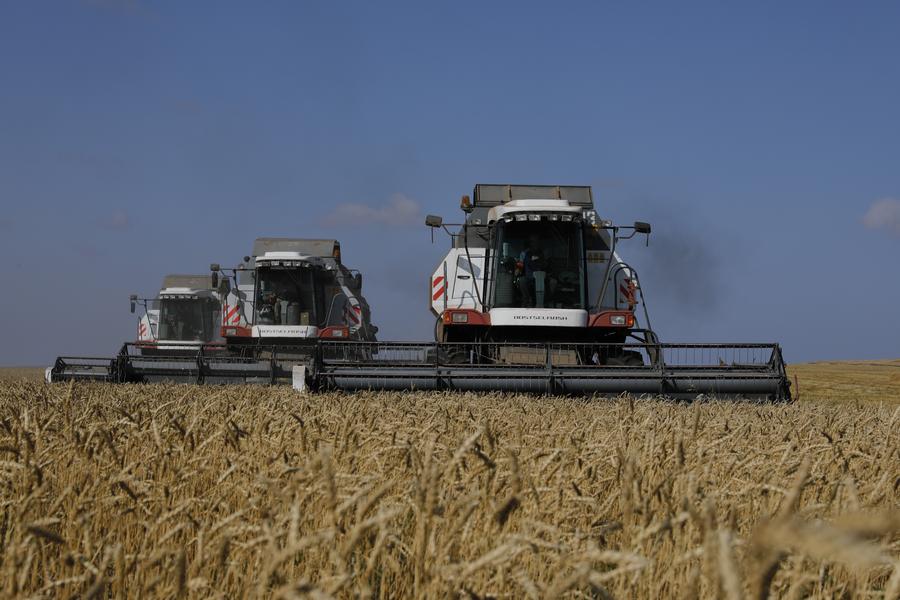Financial News
China Focus: CO boosts agricultural bonds between China, Central Asia

Farmers harvest grain in a farm in Turgen village, Akmola Region, Kazakhstan, Sept. 9, 2020. (Photo by Kalizhan Ospanov/Xinhua)
A map of Central Asia hangs on the wall of Professor Zhang Zhengmao's office at Northwest A&F University. Over the years, he has marked his journeys on the map as reminders of his travels.
So far, he has been to 10 localities in Kazakhstan, leaving his unique trace in the advancement of agricultural cooperation between China and Kazakhstan under the framework of the Shanghai Cooperation Organization (SCO).
Kazakhstan is one of the world's major grain-exporting countries with fertile soil and abundant light and heat resources, which makes it suitable for wheat cultivation, Zhang said.
However, the local wheat lacks resistance to diseases and lodging, issues that Chinese experts have already dedicated significant research efforts towards addressing. China is an important market for Kazakhstan's grain exports, and the complementary advantages between the two countries make their cooperation a natural fit, he said.
Zhang visited Kazakhstan for the first time in 2017 to participate in a China-Kazakhstan agricultural science and technology demonstration park construction project.
To cultivate varieties that are more suitable for Kazakhstan, his team collaborated with breeding units from northwest China's Gansu and Xinjiang. Through a series of experiments, they carefully selected varieties that exhibited significant advantages in terms of kernels per spike, thousand-kernel weight, and plumpness.
"The high-quality seed varieties provided by the Chinese have improved the yield and quality of Kazakhstan's wheat, and the products have also been well received by Chinese consumers," said Azbai, deputy general manager of a logistics and processing park for agricultural products in Kazakhstan.
The China-Kazakhstan agricultural sci-tech demonstration park is one of the eight such parks established by Northwest A&F University overseas under the framework of the SCO and the Belt and Road Initiative.
Another example is the establishment of the China-Kyrgyzstan fruit breeding technology demonstration park. Professor Zhang Dong from Northwest A&F University has dedicated almost seven years to the project, which aims to enhance apple production, given the fruit's popularity among the local people.
Despite Kyrgyzstan's hot and dry summer climate, the apple seedlings cultivated and selected by Zhang's team boast significantly higher water utilization efficiency and survival rate than traditional seedlings. The local apple yield had subsequently increased by more than 300 kilograms per mu (0.067 hectares).
The flow of technicians and students goes both ways between China and Central Asia along the Silk Road.
Maksat Batyrbek, a Kazakh student at Northwest A&F University, came to China to study in 2017. Having just finished his studies in June, which mainly focused on the impact of fertilization on soil microorganisms, maize leaves and rhizomes, he will soon return to his hometown.
"These are all research directions closely related to Kazakhstan's agriculture. I hope to broaden my thinking and advance my own research by learning from China's agricultural models and technologies," said Batyrbek.
For agricultural professionals, there is also fertile ground paved on the basis of cooperation under the SCO.
Established in Yangling of northwest China's Shaanxi Province in 2019, the SCO Demonstration Base for Agricultural Technology Exchange and Training has trained over 2,200 agricultural officials and technicians from SCO member states. It has also organized various agricultural technology lectures that have attracted over 40,000 online participants.
Chen Wei, associate professor with the School of Agricultural Economics and Rural Development at Renmin University of China, believes that enhancing agricultural exchanges and cooperation among SCO member states can help maintain smooth industrial and supply chains, ensure regional and global food security, and contribute more to global poverty reduction.
"For the future, more diversified agricultural investment models, closer alignment of agricultural and rural policies, and more concrete collaborative sci-tech innovation will continue to unleash the potential for sustainable agricultural development," Chen said.
Learn more: Belt and Road Initiative map
About BELT AND ROAD PORTAL
The Belt and Road Portal is the official website for Belt and Road Initiative (BRI). It responds to major concerns at home and abroad in a timely manner, interprets key concepts about the Belt and Road Initiative (BRI), releases latest BRI-related information, presents latest achievements of Belt and Road cooperation, and provides information services and communication channels for enterprises, social organizations and citizens to actively participate in Belt and Road cooperation.
Media Contact
Company Name: BELT AND ROAD PORTAL
Contact Person: Media Relations
Email: Send Email
Country: China
Website: https://www.yidaiyilu.gov.cn
Stock quotes supplied by Barchart
Quotes delayed at least 20 minutes.
By accessing this page, you agree to the following
Privacy Policy and Terms and Conditions.



